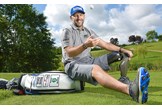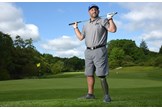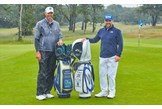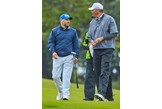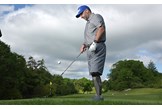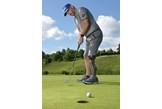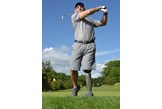From beginner to Pro in 2.5 years… on one leg!
Published: Last updated:
Mike Browne has made fast progress since taking up golf as an Army amputee. His advice will make you a better golfer, while his story cannot fail to inspire you
Imagine I told you about a man who didn’t pick up a golf club until he was 36 years old. Imagine that, within a year, his handicap had plummeted from 28 to eight. Within three years of taking up the game, he’d turned professional and won events in multiple continents, beat Ian Woosnam, nearly qualified for the Open, shot rounds in the low 60s and recently impressed ninetime PGA Tour winner Matt Kuchar during a round together at The Renaissance Club. You’ve just imagined Mike Browne. Oh, and I should probably mention, Mike Browne has only one leg.
Eight years ago, Browne suffered a broken leg during a routine training exercise at Longmoor Military Camp. He was part of the Unit Corps for the Royal Artillery, a unit he’d served since joining the Army as a 20-year-old. What he expected to be a minor setback in his military career turned into a life-changing incident. Two years later, Browne still hadn’t recovered, the result of a rare infection which had eaten away all the muscle in his leg. On May 1, 2013, Mike and his surgeon decided amputation was their best option. The operation took place six days later.
“It wasn’t a hard decision to take,” says Mike. “I know it sounds like a hard decision, having your leg amputated, but I’d been through two years of absolute hell. I hadn’t been in a very good place and I’d done everything I could. I’d already had 16 operations at that point.”
The amputation was a success, and Mike tackled the physical rehabilitation with determination and vigour, learning to walk again with the aid of a prosthetic leg. But the hard work had just begun, as the mental recovery would be the toughest challenge he’d ever faced.

“The fact something was missing from me was hard to deal with,” he says. “I didn’t really leave the house for about six months. I didn’t see anyone outside of the rehab I was doing at Headley Court. There was a lot of stuff going on in my own head.”
It was after a rehabilitation session at Tedworth House that he spotted a poster that would change his life. It was an advert for the On Course Foundation (www.oncoursefoundation.com), a charity that helps sick and injured service personnel to get their lives back on track through golf. Mike signed up for a one-day taster session and was immediately hooked.
“I fell in love with it,” he says. “Don’t get me wrong, I was absolutely useless to start with. But then I hit a ball one day and it went pretty straight. I thought, ‘Ah, I can do this.’”
To say he can do it is something of an understatement. Mike’s passion for the game, and for competition – he’d been a good footballer and a British and European-level motocross rider before his accident – made him determined to get a handicap as quickly as he could, and then work on getting it down.
“I got my first handicap in July 2014. I was off 28. I’ve still got the scorecard from my first ever round of golf. I shot 148. I loved it, all 148 shots of it!” It took Mike just three months to get from 28 to 15, and little more than a year to go from complete beginner to solid 8-handicapper. The 41-year-old now regularly shoots in the 60s on championship courses, and has gone as low as 62 at Ashridge GC, just north of London.
“I just sort of turned it into my job straight away,” he says. “I would go to the range at eight in the morning until half-four in the afternoon and treat it as a working day, because that’s what I was used to doing in the military. I say I treated it like a job, but it never felt like work, because I loved it. It was either that or sit at home and feel sorry for myself. I didn’t want to do that.

“Golf got me back into the social side of things as well. Golf changed my life, without a doubt. It might even have saved my life. Before I found golf, I had nothing. I didn’t know where I was going. I was out of the military, stuck at home, doing nothing. I was going down a slippery slope into depression. Who knows where I’d have been if it wasn’t for golf?”
Mike’s determination and passion has seen golf become his new vocation. He turned pro in September 2016, little more than two years after picking up a club for the first time.
“I was invited to play in the Willow Classic on the Senior Tour. I shot 5-under for my three rounds and beat quite a lot of the blokes – including Ian Woosnam, which was a really proud moment. It planted a seed in my head about turning pro and I thought, ‘Yeah, why not? Let’s do it.’”
Mike made his professional debut in Spain on The Gecko Tour in October 2016 and now splits his time between golf’s satellite tours and the European Disabled Golf Association. He won the 2018 South African Disabled Golf Open by an astonishing 12 shots and successfully defended his title this year. He’s currently ranked third in the world for golfers with disabilities, and he’s on course to take the top spot soon. He represented Great Britain in the Simpson Cup at Oakhill, the equivalent of the Ryder Cup for wounded and sick veterans.
He has sponsorship from Skechers, Bushnell, Callaway and Max Golf Protein and, by the time you read this, will have become the first amputee to compete in the British Par 3 Championship alongside European Tour stalwarts. At last year’s Open qualifying, Mike was just one shot shy of making it through to the final stage, despite finding 13 bunkers on the back nine at the notoriously tricky Fairhaven. He has lofty expectations, but remains grounded.
“I want to go as far as I can,” he says, “but you’ve got to be realistic with these things. I would love to play on the main European Tour but, being realistic, I’m just happy plodding away and making progress. You never know where you’re going to end up.”
But Mike’s main goal is to inspire others like him to give golf a try, due to his first-hand experience of what a difference it can make.
“I can’t over-emphasise how important it is to try golf. If you’ve got anything physical or mental wrong with you, golf has got everything. It’s got everything you need to rehabilitate yourself. It’s a life-changer and it doesn’t matter if you’ve got a disability or not; taking up golf changes you as a person and brings out the true person you really are.”
The day he played golf with Matt Kuchar
Mike played with Kuchar at The Renaissance Club while he prepared for the EDGA Scottish Open and Kuch for the Scottish Open. Here’s what the nine-time PGA Tour winner saw in our man’s game…

“It’s so impressive to see Mike overcome his handicap and to be playing golf like he does. We travel all around the world and get to see all kinds of different people in different circumstances who love the game. It’s so inspirational to see somebody overcome something so potentially devastating that takes you away from the things you love doing.
“To see Mike still be able to do what he loves doing, and to do it at a highly competitive level is awesome. It’s just fantastic to see such people still chasing their dreams and enjoying what they love doing. To have the game he does when he’s only been playing for five years is truly remarkable.
“That’s one of the beauties about the game of golf – the ability of people to remain competitive. You see ex-athletes from other sports who are no longer playing their sport competitively use golf to become their outlet.
“For Mike, I can see that golf has become an outlet for him and he’s chasing new dreams – it’s really cool to see. Only last year I played in the RBC Open and there was a similar tournament to this one where golfers with disabilities were playing in a tournament alongside the pros. It was so cool to see them out on the range. There was a similar event during the World Cup in Australia.
“It’s been great to see the inclusion of everybody, to see how good people can be in a different endeavour, and to see the game grow.”

How to get good… fast: The principles that took Mike from beginner to pro in 2.5 years
1. LISTEN
This is the biggest thing, for me – just listening. I’m a big believer in not being a know-it-all and just listening to advice. You can’t beat experience in golf, so no matter what handicap you are, someone is going to know something different. I’ll listen to anyone. I played with a guy who was off 23, but his short game was unbelievable. I asked him what he was doing, he showed me, and it made a massive difference to my game. He got me to try narrowing my stance and turning my body more, rather than trying to hit the ball. I was looking to get some more spin on my short shots and it worked, so that’s now in my game. I never would have got that if I’d written him off just because he was a higher handicapper.
2. SHORT GAME FOCUS
I spend at least 70 per cent of my practice time on short game. You can just sit on the range bashing balls, but if you aren’t hitting them right then you’re just learning bad habits. Short game, from 130 yards and in – that’s the yardage that determines your score. Short game and putting is the way of lowering your scoring. If you can hole three more putts every round, that’s a lot of strokes you’re going to gain.
3. VARIABLE PRACTICE
I don’t hit loads of balls from one spot. I hit two or three, maximum, and then I’ll swap positions. If you just keep hitting the same shot then of course you’re going to get it, but what are you learning? You don’t get 20 goes on the course. I’ll go on the course in the evening, when it’s pretty dead, and just drop one down at 130 yards, one at 120 yards, and just play like that.
4. DIAL IN YOUR WEDGES
I’ve got three different yardages for each wedge – a half swing, a three-quarter swing and a full swing. I use a clock method, so it’s actually 7.30, 9.30 and then 10.30 on the clock face. For some people a full swing would be 12 o’clock, but I can’t make a full swing due to my leg. I know the yardage each of my wedges goes with each of those swings. I just spent a bit of time on Trackman. It’s all about developing the feeling of how far you’re taking the club back. I’m pretty dialled in on them now.
5. PRESSURE PRACTICE
I like to play games in practice to make it more fun and add pressure, where you score points for getting it within a certain distance or past the hole. I like to play them against other people, even just for a drink. If you add that little bit of pressure, it makes it more fun, and when you’re in a tournament and feeling pressure you’ll be more used to it and able to cope.

6. SWING YOUR OWN SWING
My leg does have an effect, but I’ve learnt to overcome it. I’m never going to have a textbook PGA Tour swing, but it’s effective, it works, and it’s good for me. It’s not about there being a right or wrong way to do things. Just try different things and experiment. Some things will work, some won’t. Either way, you’re finding out about yourself as a golfer and improving a lot more than you would be if you’re searching for the ‘perfect’ method of doing things. You’ve only got to look at the best players in the world: they all have their own way of doing things, but they’ve found what works for them through trial and error.
7. TRACK YOUR STATS
I never used to be into stats but I like it now. It gives me an idea of what’s happening and what I need to work on. I do fairways, greens and putts, but I also track whether I missed the green right or left, short or long. If you’re always short, you know you’re hitting the wrong club. If you mainly miss the green on one side, you can work on fixing it. You’re learning about yourself as a golfer and that’s the only way you can make genuine improvements.

